Abstract
1. Single afferent fibres with receptive fields in the diaphragm (272 units) dissected from the right phrenic nerve were classified according to the following properties: reaction to contraction of the diaphragm, resting activity, conduction velocity, location and properties of receptive fields, and reaction to injection of bradykinin and lactic acid into the internal thoracic artery. Nine additional fibres dissected from the phrenic nerve had receptive fields outside the diaphragm. The experiments were performed on chloralose-anaesthetized cats. 2. Ninety-six fibres (36%) had high resting activity when unloaded by contraction of the diaphragm, had low-threshold receptive fields in the muscle and were mostly group II and III fibres. They probably innervated muscle spindles. 3. Eighty-eight fibres (32%) were vigorously activated by contraction of the diaphragm. They had low-threshold receptive fields located in the musculotendinous border and central tendon. Their conduction velocity was in the range for group II and III fibres. We infer that they may innervate tendon organs. 4. Eighty-eight fibres (32%) were slightly affected or not affected by diaphragmatic contraction. They had low- and high-threshold receptive fields located mostly in the muscular part of the diaphragm, and negligible resting activity. Most of them were group III and IV afferent fibres and were activated when bradykinin and lactic acid were applied to their receptive fields. Possibly these low- and high-threshold receptors innervated diaphragmatic ergo- and nociceptors, respectively. 5. Sensory outflow from the diaphragm was found to be somatotopically organized, so that fibres with receptive fields in the sternocostal portion were predominantly located in the upper phrenic nerve root, and those with lumbar receptive fields were in the lower root. 6. It is concluded that the phrenic nerve contains fibres from several distinct classes of sensory receptors: muscle spindles, tendon organs, ergoceptors and nociceptors. The sensory diaphragmatic outflow to the spinal cord is somatotopically organized.
Full text
PDF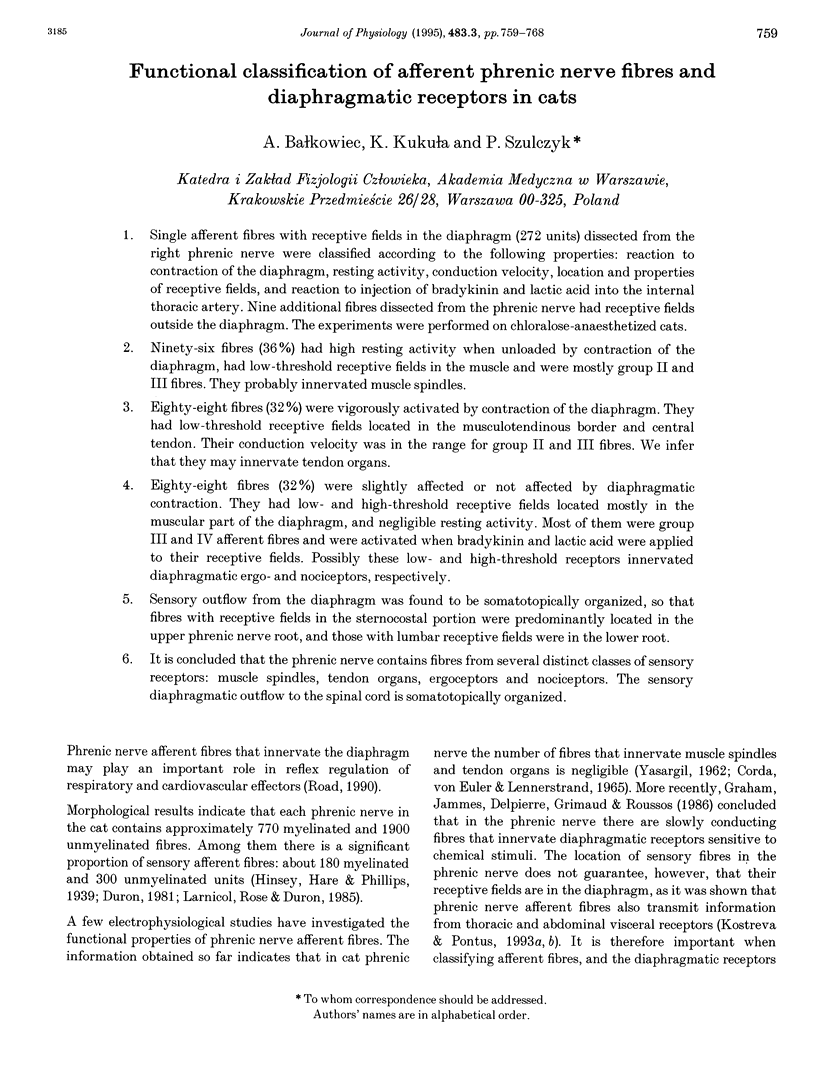
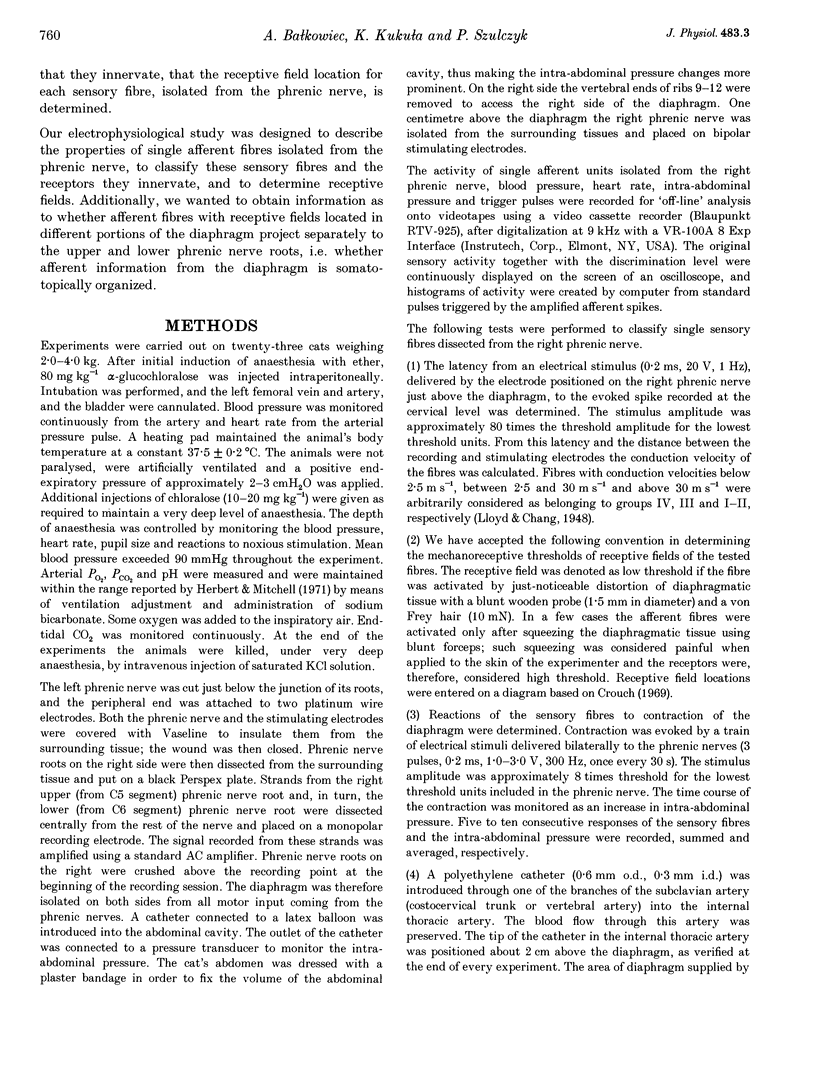
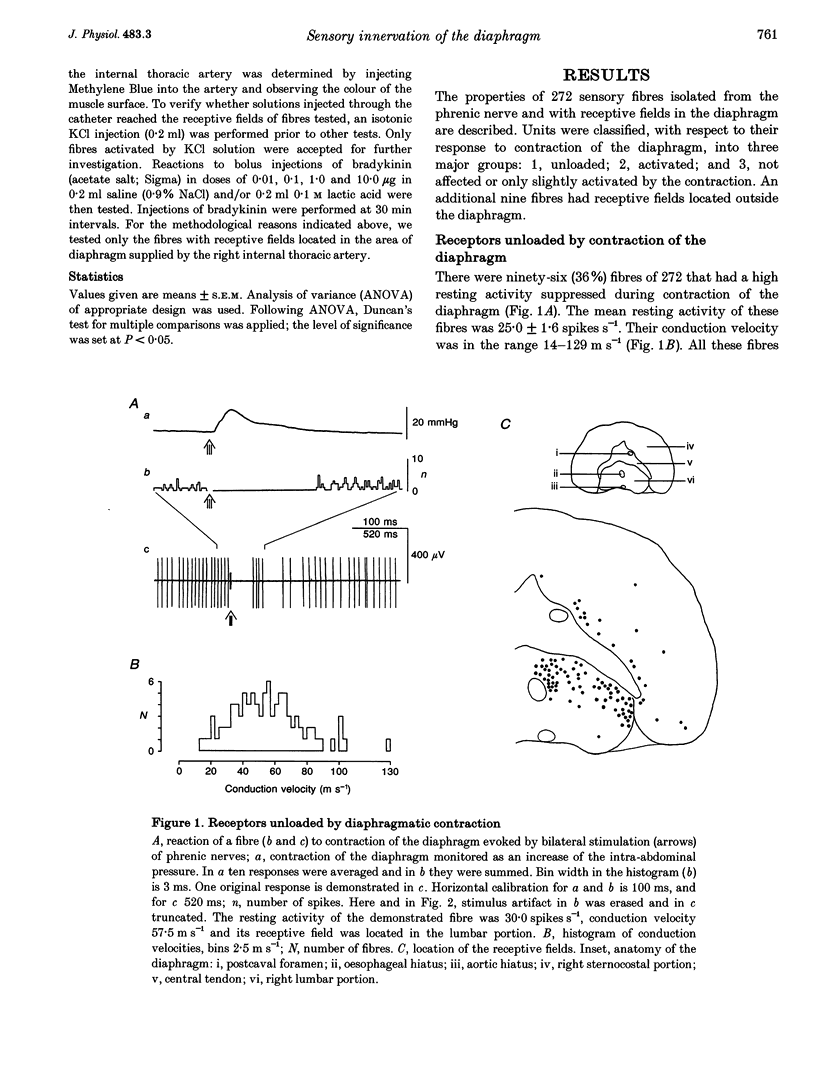
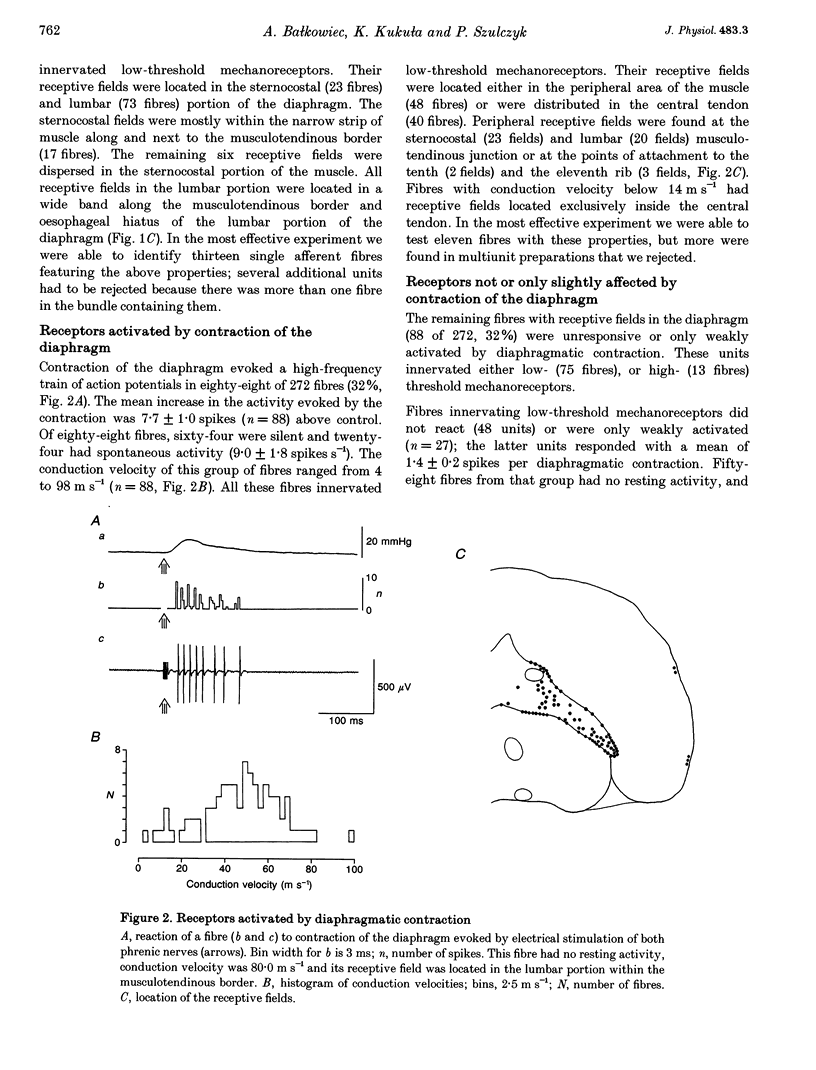
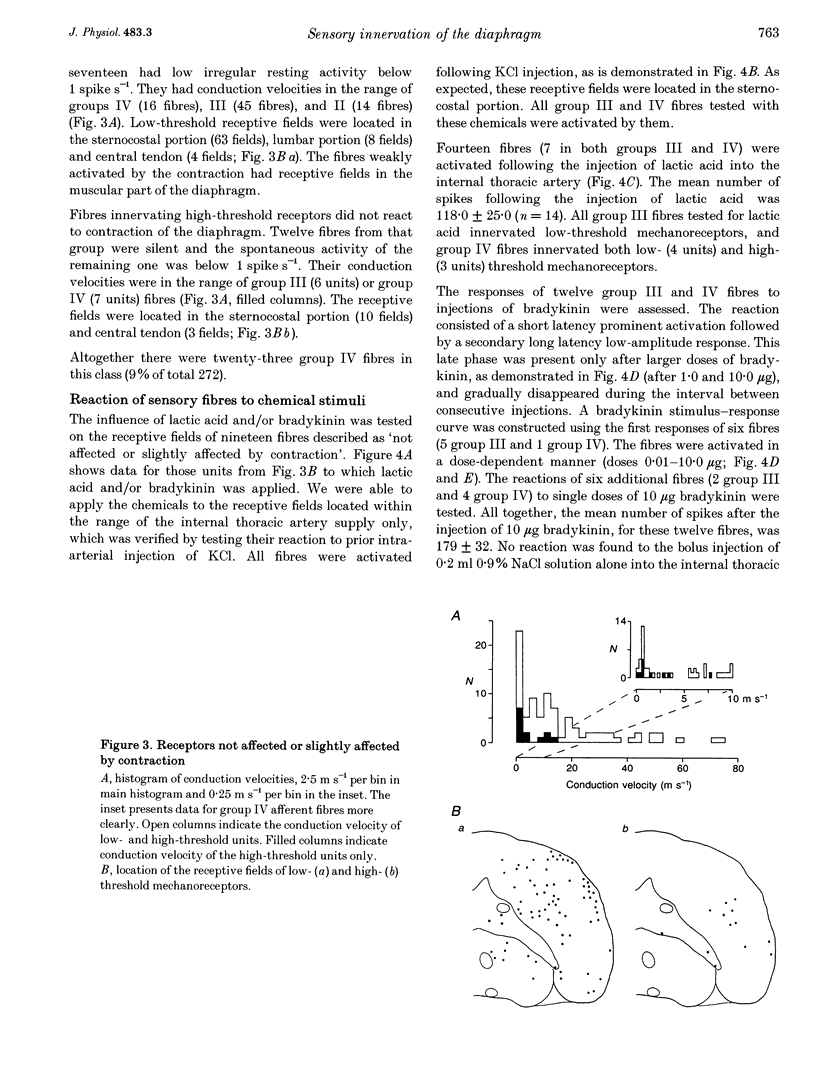
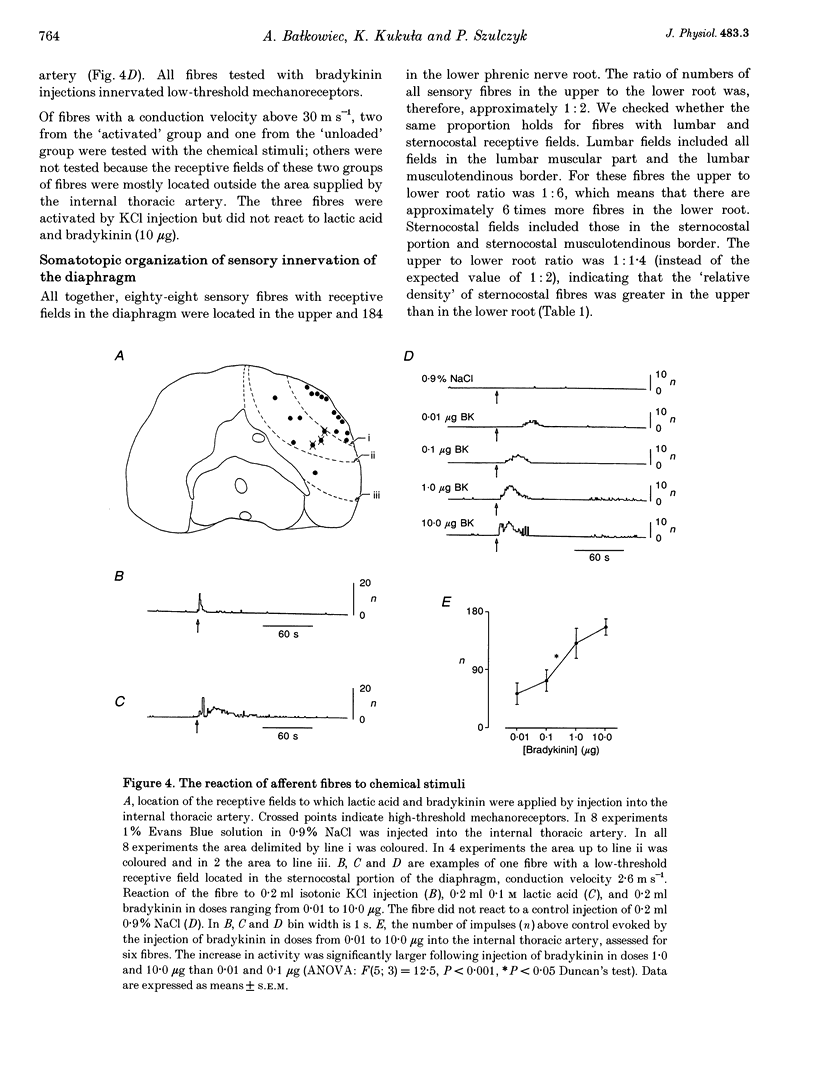
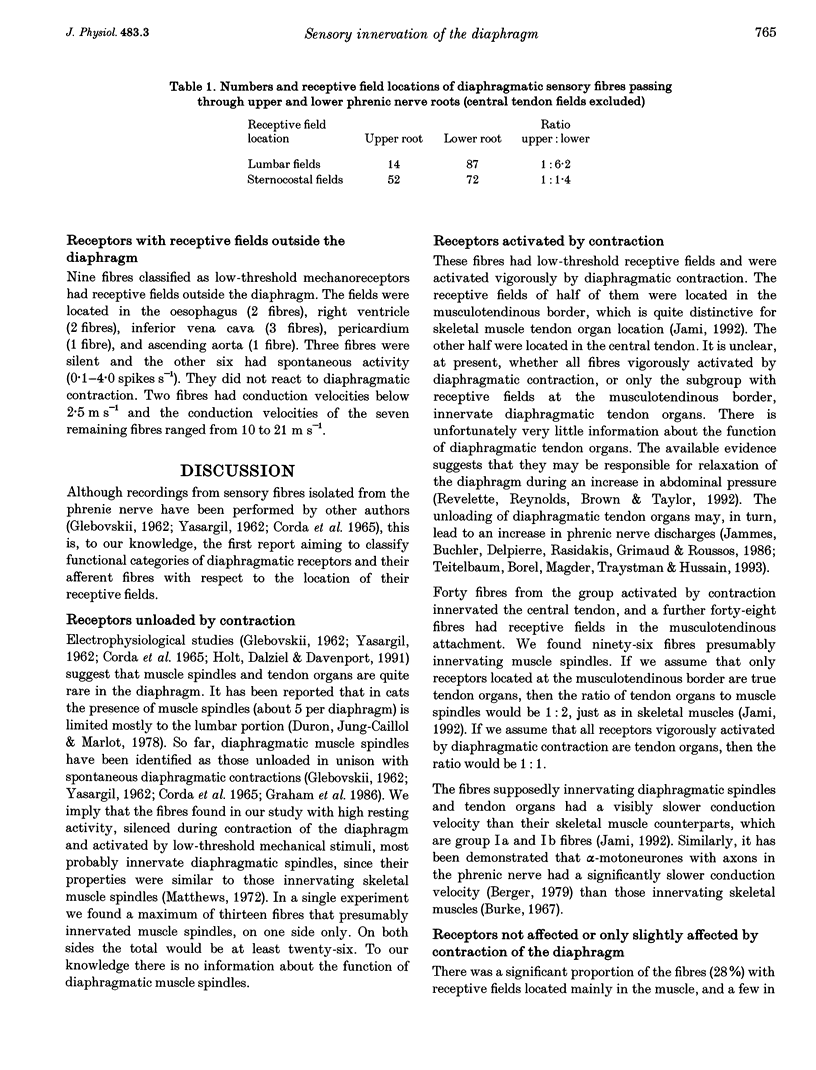
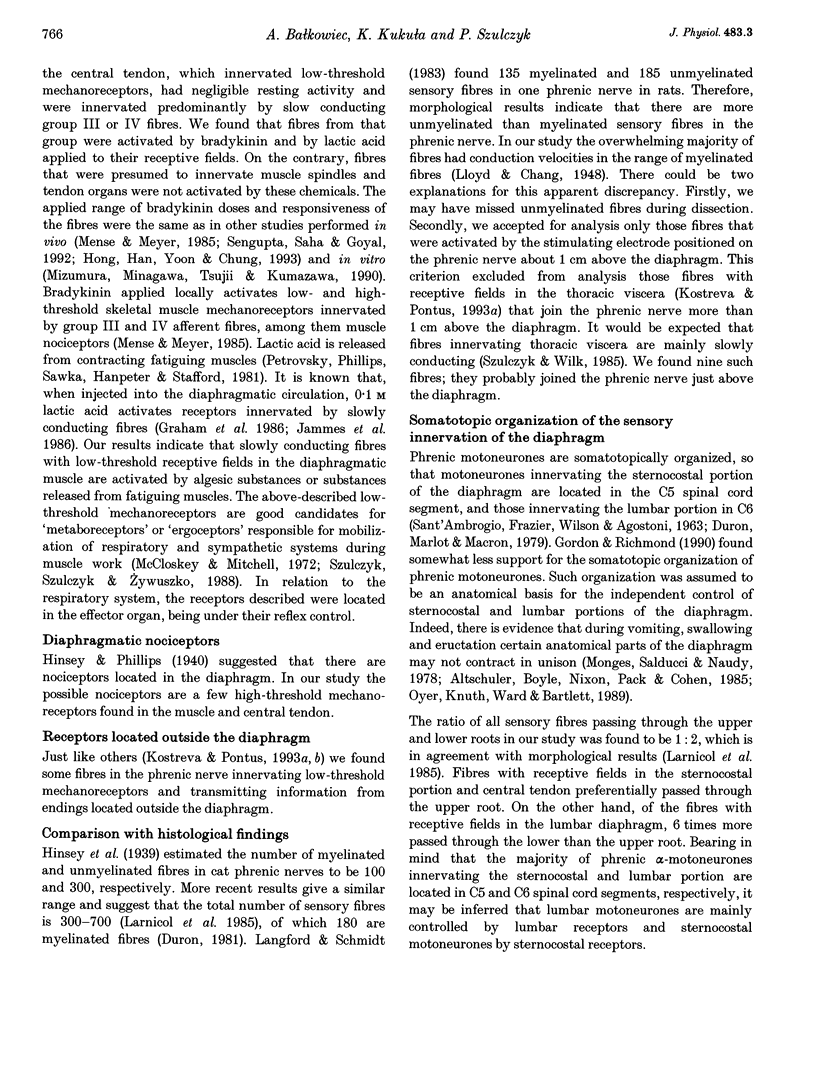
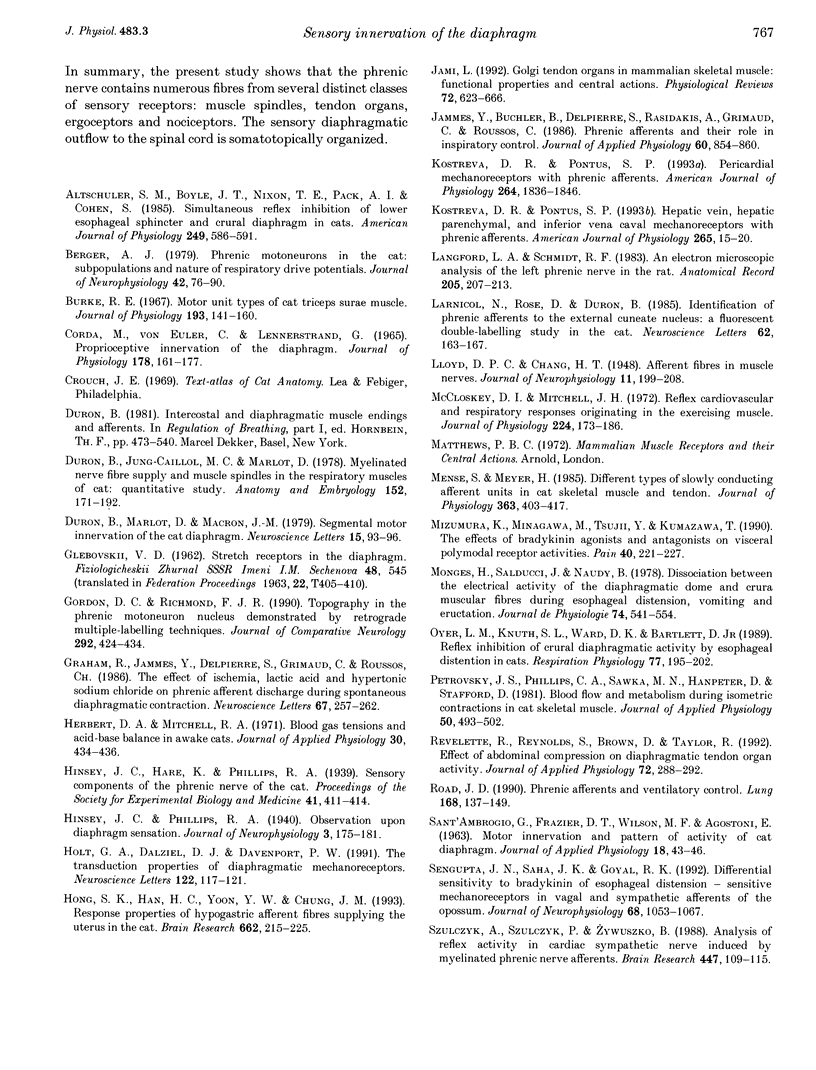
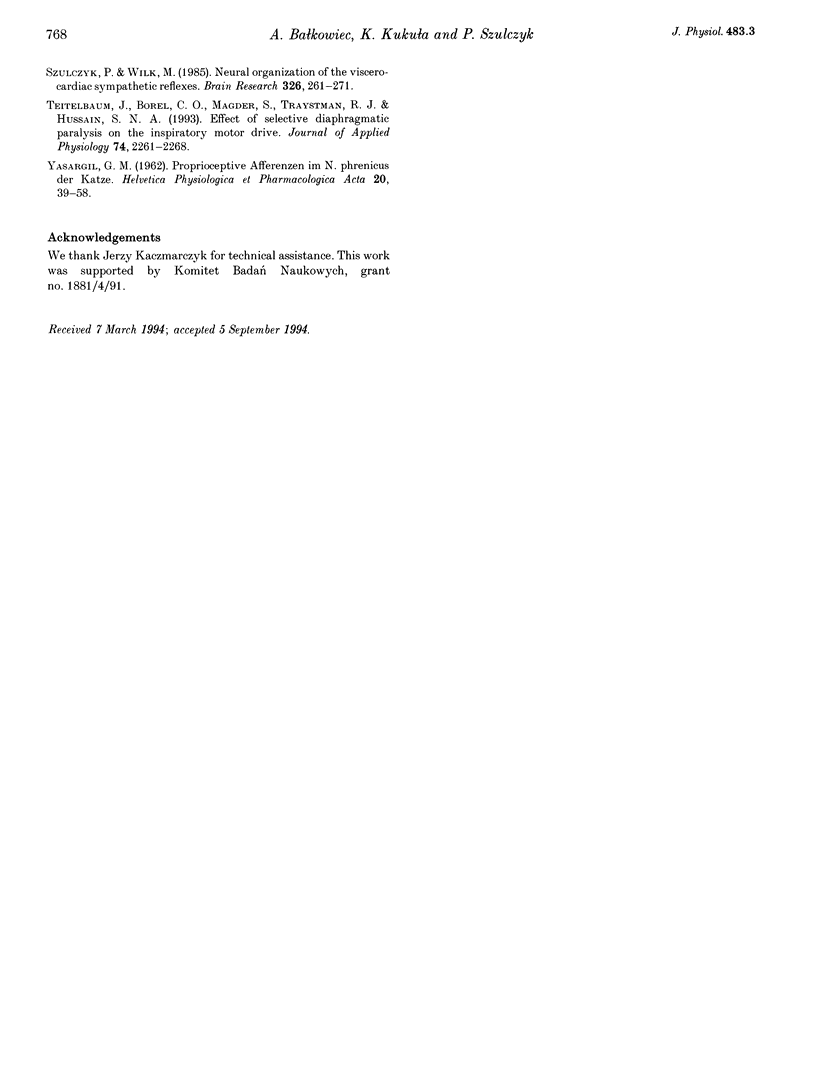
Selected References
These references are in PubMed. This may not be the complete list of references from this article.
- Berger A. J. Phrenic motoneurons in the cat: subpopulations and nature of respiratory drive potentials. J Neurophysiol. 1979 Jan;42(1 Pt 1):76–90. doi: 10.1152/jn.1979.42.1.76. [DOI] [PubMed] [Google Scholar]
- Burke R. E. Motor unit types of cat triceps surae muscle. J Physiol. 1967 Nov;193(1):141–160. doi: 10.1113/jphysiol.1967.sp008348. [DOI] [PMC free article] [PubMed] [Google Scholar]
- CORDA M., VONEULER C., LENNERSTRAND G. PROPRIOCEPTIVE INNERVATION OF THE DIAPHRAGM. J Physiol. 1965 May;178:161–177. doi: 10.1113/jphysiol.1965.sp007621. [DOI] [PMC free article] [PubMed] [Google Scholar]
- Duron B., Jung-Caillol M. C., Marlot D. Myelinated nerve fiber supply and muscle spindles in the respiratory muscles of cat: quantitative study. Anat Embryol (Berl) 1978 Feb 20;152(2):171–192. doi: 10.1007/BF00315923. [DOI] [PubMed] [Google Scholar]
- Duron B., Marlot D., Macron J. M. Segmental motor innervation of the cat diaphragm. Neurosci Lett. 1979 Dec;15(2-3):93–96. doi: 10.1016/0304-3940(79)96095-6. [DOI] [PubMed] [Google Scholar]
- GLEBOVSKII V. D. [On stretch receptors of the diaphragm]. Fiziol Zh SSSR Im I M Sechenova. 1962 May;48:545–553. [PubMed] [Google Scholar]
- Gordon D. C., Richmond F. J. Topography in the phrenic motoneuron nucleus demonstrated by retrograde multiple-labelling techniques. J Comp Neurol. 1990 Feb 15;292(3):424–434. doi: 10.1002/cne.902920308. [DOI] [PubMed] [Google Scholar]
- Graham R., Jammes Y., Delpierre S., Grimaud C., Roussos C. The effects of ischemia, lactic acid and hypertonic sodium chloride on phrenic afferent discharge during spontaneous diaphragmatic contraction. Neurosci Lett. 1986 Jun 30;67(3):257–262. doi: 10.1016/0304-3940(86)90318-6. [DOI] [PubMed] [Google Scholar]
- Herbert D. A., Mitchell R. A. Blood gas tensions and acid-base balance in awake cats. J Appl Physiol. 1971 Mar;30(3):434–436. doi: 10.1152/jappl.1971.30.3.434. [DOI] [PubMed] [Google Scholar]
- Holt G. A., Dalziel D. J., Davenport P. W. The transduction properties of diaphragmatic mechanoreceptors. Neurosci Lett. 1991 Jan 14;122(1):117–121. doi: 10.1016/0304-3940(91)90207-a. [DOI] [PubMed] [Google Scholar]
- Hong S. K., Han H. C., Yoon Y. W., Chung J. M. Response properties of hypogastric afferent fibers supplying the uterus in the cat. Brain Res. 1993 Sep 17;622(1-2):215–225. doi: 10.1016/0006-8993(93)90822-5. [DOI] [PubMed] [Google Scholar]
- Jami L. Golgi tendon organs in mammalian skeletal muscle: functional properties and central actions. Physiol Rev. 1992 Jul;72(3):623–666. doi: 10.1152/physrev.1992.72.3.623. [DOI] [PubMed] [Google Scholar]
- Jammes Y., Buchler B., Delpierre S., Rasidakis A., Grimaud C., Roussos C. Phrenic afferents and their role in inspiratory control. J Appl Physiol (1985) 1986 Mar;60(3):854–860. doi: 10.1152/jappl.1986.60.3.854. [DOI] [PubMed] [Google Scholar]
- Langford L. A., Schmidt R. F. An electron microscopic analysis of the left phrenic nerve in the rat. Anat Rec. 1983 Feb;205(2):207–213. doi: 10.1002/ar.1092050211. [DOI] [PubMed] [Google Scholar]
- Larnicol N., Rose D., Duron B. Identification of phrenic afferents to the external cuneate nucleus: a fluorescent double-labeling study in the cat. Neurosci Lett. 1985 Dec 4;62(2):163–167. doi: 10.1016/0304-3940(85)90349-0. [DOI] [PubMed] [Google Scholar]
- McCloskey D. I., Mitchell J. H. Reflex cardiovascular and respiratory responses originating in exercising muscle. J Physiol. 1972 Jul;224(1):173–186. doi: 10.1113/jphysiol.1972.sp009887. [DOI] [PMC free article] [PubMed] [Google Scholar]
- Mense S., Meyer H. Different types of slowly conducting afferent units in cat skeletal muscle and tendon. J Physiol. 1985 Jun;363:403–417. doi: 10.1113/jphysiol.1985.sp015718. [DOI] [PMC free article] [PubMed] [Google Scholar]
- Mizumura K., Minagawa M., Tsujii Y., Kumazawa T. The effects of bradykinin agonists and antagonists on visceral polymodal receptor activities. Pain. 1990 Feb;40(2):221–227. doi: 10.1016/0304-3959(90)90072-L. [DOI] [PubMed] [Google Scholar]
- Monges H., Salducci J., Naudy B. Dissociation between the electrical activity of the diaphragmatic dome and crura muscular fibers during esophageal distension, vomiting and eructation. An electromyographic study in the dog. J Physiol (Paris) 1978 Dec;74(6):541–554. [PubMed] [Google Scholar]
- Oyer L. M., Knuth S. L., Ward D. K., Bartlett D., Jr Reflex inhibition of crural diaphragmatic activity by esophageal distention in cats. Respir Physiol. 1989 Aug;77(2):195–202. doi: 10.1016/0034-5687(89)90006-6. [DOI] [PubMed] [Google Scholar]
- Petrofsky J. S., Phillips C. A., Sawka M. N., Hanpeter D., Stafford D. Blood flow and metabolism during isometric contractions in cat skeletal muscle. J Appl Physiol Respir Environ Exerc Physiol. 1981 Mar;50(3):493–502. doi: 10.1152/jappl.1981.50.3.493. [DOI] [PubMed] [Google Scholar]
- Revelette R., Reynolds S., Brown D., Taylor R. Effect of abdominal compression on diaphragmatic tendon organ activity. J Appl Physiol (1985) 1992 Jan;72(1):288–292. doi: 10.1152/jappl.1992.72.1.288. [DOI] [PubMed] [Google Scholar]
- Road J. D. Phrenic afferents and ventilatory control. Lung. 1990;168(3):137–149. doi: 10.1007/BF02719685. [DOI] [PubMed] [Google Scholar]
- SANT'AMBROGIO G., FRAZIER D. T., WILSON M. F., AGOSTONI E. Motor innervation and pattern of activity of cat diaphragm. J Appl Physiol. 1963 Jan;18:43–46. doi: 10.1152/jappl.1963.18.1.43. [DOI] [PubMed] [Google Scholar]
- Sengupta J. N., Saha J. K., Goyal R. K. Differential sensitivity to bradykinin of esophageal distension-sensitive mechanoreceptors in vagal and sympathetic afferents of the opossum. J Neurophysiol. 1992 Oct;68(4):1053–1067. doi: 10.1152/jn.1992.68.4.1053. [DOI] [PubMed] [Google Scholar]
- Szulczyk A., Szulczyk P., Zywuszko B. Analysis of reflex activity in cardiac sympathetic nerve induced by myelinated phrenic nerve afferents. Brain Res. 1988 Apr 26;447(1):109–115. doi: 10.1016/0006-8993(88)90970-5. [DOI] [PubMed] [Google Scholar]
- Szulczyk P., Wilk M. Neural organization of the viscero-cardiac reflexes. Brain Res. 1985 Feb 11;326(2):261–271. doi: 10.1016/0006-8993(85)90035-6. [DOI] [PubMed] [Google Scholar]
- Teitelbaum J., Borel C. O., Magder S., Traystman R. J., Hussain S. N. Effect of selective diaphragmatic paralysis on the inspiratory motor drive. J Appl Physiol (1985) 1993 May;74(5):2261–2268. doi: 10.1152/jappl.1993.74.5.2261. [DOI] [PubMed] [Google Scholar]
- YASARGIL G. M. [Proprioceptive afferent impulses in the phrenic nerve of the cat]. Helv Physiol Pharmacol Acta. 1962;20:39–58. [PubMed] [Google Scholar]


